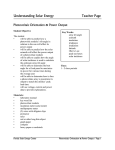Download Grades 9-12 - EnergyWhiz
Transcript
SunSmart Schools IV Teacher Page We’ve Got the Power! Student Objective The student: • will be able to explain the relationship between irradiance and the amount of power (DC) output of the photovoltaic array • given a graph of a photovoltaic system’s power output will be able to deduce what the weather was for the given day • given the weather outside and the time, will be able to approximate the power output of the array Materials: • computer or handheld device with internet access • computer with internet access capable of projecting for the class (alternately, graphs could be reproduced on overhead transparencies) • web based weather application with current and historical (past month) weather data Key Words: amperage current direct current (DC) irradiance kilowatts per hour (kWh) photovoltaic array power voltage watts/kilowatts Time: 1 class period Background Information Local weather has a dramatic effect on the electrical output from a photovoltaic array. The most obvious factor is cloud cover, but temperature also affects the output from the array (higher temperatures decrease the electrical output slightly–this will be covered in the later lesson, Changes in Latitude). Additionally, in areas without adequate rainfall, the photovoltaic output can be adversely affected by an accumulation of dust and bird droppings, and of course snow cover will block sunlight from reaching the surface of the solar cells. Luckily in Florida, we don’t usually have to worry about either of these two conditions! Irradiance is the measure of the intensity of sunlight, and is expressed as watts per square meter (W/m2). On a sunny, clear-sky day at solar noon, at sea level, the typical irradiance level is 1,000 W/m2. This value of irradiance is used as the standard test condition (STC) for Florida Solar Energy Center W e’ve Got the Power! / Page 1 photovoltaic testing and design calculations, and is the basis of the manufacturers stated output for cells and panels. On a clear cloudless day, irradiance will peak at solar noon; a graph of irradiance over time will produce a bell shaped curve. Large banks of clouds, thunderstorms and weather fronts are all readily apparent on a graph of irradiance, and since photovoltaic output is directly related to irradiance, these weather events can be seen on a graph of the output. On consistently overcast days, the curve will have the same width but will be much lower, and on partly cloudy days with patch of clouds intermingled with bright sun, the curve will tend to be spiky, showing that the system produces more energy during sunny periods and less energy during cloudy periods. Procedure (prior to class) Note: Students should have completed the lesson “Solar Powered System 1” from Understanding Solar Energy prior to beginning this activity. 1. Familiarize yourself with the Sun Town static graphs on the Energy Whiz website. These can be accessed by selecting the Sun Town school on the pull down menu. 2. Familiarize yourself with the data being collected for your school’s system, or alternately if your school does not have a monitored photovoltaic array, choose an available school from the list on the Energy Whiz website, (www.energywhiz.com) for classroom use. If possible, use a school that is nearby or one that usually has the same general weather patterns as your school. Navigate through the different screens, so you will be able to guide your students in locating irradiance and DC output, and also historical data (irradiance and DC output) for the last month. 3. Locate a weather app that gives accurate current and historical weather data for your school (or the school you have chosen). Procedure (during class) 1. If necessary, divide the students into groups according to how many computers are available to them. 2. Lead the class in a discussion/review of their findings from previous lesson on the different factors that can affect the output of photovoltaics, making sure that weather is mentioned and discussed. 3. Tell the students that they will be investigating how weather conditions affect the amount of electricity that the array at their school produces. 4. Lead a discussion on the nature of sunlight during the day. • Ask the class to describe how the ‘brightness’ of sunlight changes throughout the day. • Guide the students to talk about how the light from the Sun gets stronger and brighter from dawn to solar noon, and then slowly gets weaker and dimmer until sundown. 5. Draw the framework of a two axis graph on the board (intensity of sunlight on the y and time on the x. Don’t worry about putting any numerical values on the y axis yet). Ask Florida Solar Energy Center W e’ve Got the Power! / Page 2 5. 6. students to draw on a sheet of paper what they think a graph of the intensity of sunlight would look like. (Students may work in groups or individually) • After the majority of students have put something on their paper, ask for a volunteer to share their idea on the board. • Lead a discussion about this graph; have students modify the graph to show their suggestions. Guide them if necessary. • When the students have closely approximated a bell shaped curve, write the Energy Whiz website address on the board and have the students navigate there and select the irradiance graph for the Sun Town school. • Have the students explain how this graph is similar and different from the graph that they created. Ask the students to describe the weather for that day. Have the students switch to the graph showing irradiance on a day with an afternoon rainstorm. They should be able to explain and point out sunrise, sunset, clouds and afternoon heavy clouds (thunderstorm). Students should complete their Laboratory Manual pages. Further Research 1. Have the students pick a school in another part of Florida and predict what the weather at that school is based off the power output. Have them check the weather service to see if they are correct. 2. Have the students shade large areas of the array with sheets of cardboard or blankets to simulate heavy clouds. Observe the output. Have them cover areas with screen or gauze material to simulate hazy conditions. Observe the output. Internet Sites http://rredc.nrel.gov/solar/old_data/nsrdb/ National Solar Radiation Database contains 30 years (1961-1990) of solar radiation and supplementary meteorological data from 237 NWS sites, plus a user manual to help in reading the tabular information. http://www.ncdc.noaa.gov/data-access/land-based-station-data/land-based-datasets/solar-r adiation/ National Oceanic and Atmospheric Administration’s (NOAA) National Climatic Data Center is responsible for preserving, monitoring, assessing, and providing public access to the Nation's treasure of climate and historical weather data and information. Here you can find data on solar radiation and climate conditions in the United States http://wrdc-mgo.nrel.gov/ World Radiation Data Centre.Worldwide solar radiation site. http://en.openei.org/wiki/Main_Page Open Energy Information (OpenEI) is a knowledge sharing online community dedicated to connecting people with the latest energy information and data. Florida Solar Energy Center W e’ve Got the Power! / Page 3 http://www.weather.com/ The Weather Channel provides local weather conditions and historical data. Florida Solar Energy Center W e’ve Got the Power! / Page 4 SunSmart Schools IV Key Word/Definitions We’ve Got the Power! amperage - measure of the number of electrons flowing through a wire (current) current - the movement of electrons direct current electricity (DC) - an electric current flowing in one direction only. This type of electricity is typically used in battery operated devices, automobiles and boats irradiance - measure of the amount of sunlight at a particular time and place kilowatt - 1000 watts kilowatts per hour (kWh) - the standard unit used to describe electricity usage over time photovoltaic array - complete unit of solar modules power - common term used to refer to output in watts voltage - measure of the force of electricity in a circuit. The volt is not a unit of flow, it is analogous to pressure of water in a hose. watts - the standard unit used to measure electricity, specifically the rate at which electrical energy is dissipated. Watts are calculated by multiplying amperage and voltage. Florida Solar Energy Center W e’ve Got the Power! / Page 5 SunSmart Schools IV Laboratory Manual We’ve Got the Power! 1. Irradiation is the scientific term for the amount of sunshine that strikes an object. How does the amount of irradiation affect the amount of electricity that your school’s photovoltaic system produces? Write a hypothesis below that describes the mathematical relationship between the amount of solar irradiance and the electric output of your system. 2. Gather the data to verify your hypothesis. On the Energy Whiz website, use irradiance and DC output graphs to support or disprove your hypothesis. Use your own school’s data (if available). Write your findings and conclusion below, using graphs and/or equations to support your conclusion. Florida Solar Energy Center W e’ve Got the Power! / Page 6 To simplify discussions about the output of photovoltaic cells, modules and arrays, scientists decided on a set of conditions, called Standard Test Condition (STC), that allow mathematical computations and comparisons to be made when input, output and module size are variable. The Standard Test Condition for irradiance is 1000 Wm2. Irradiance of this value occurs during solar noon on a clear sunny day in most parts of the world; however, here in Florida we often will have sunny days that measure higher. 3. Look at the irradiance data you collected for question 2. Which dates and times had an irradiance level of 1000 Wm2? 4. Did the irradiance level on any of these days measure greater than 1000 Wm2? If so, list which date(s) and time(s) went above standard test conditions. Once you know the irradiance level and the size of a system, you can predict how much electricity the system is producing. You may have noticed a ‘system size’ in kW listed in your school’s description. This is a shortcut that you can use when making calculations–it is the system’s ‘nameplate’ rating provided by the manufacturer. This value was obtained by testing and measuring the panel’s output at Standard Test Conditions – 1000 Wm2. Using this value, you can take the nameplate rating of any array and figure its projected output during all irradiance conditions. 5. How much electricity will your system produce when the irradiance level is at STC (1000 Wm2)? Find the ‘system size’ in your school description. Record it here: System size = ____________ m2 This value is how much electricity your system is expected to be producing when the irradiance is 1000 Wm2. To check your projection of output, check your graphs from question 2 for the times when the irradiance was 1000Wm2. Is your projection correct? Describe any difference. What might account for this difference? Florida Solar Energy Center W e’ve Got the Power! / Page 7 6. What would your system produce when the irradiance is 750Wm2? Show your calculations below. 7. Calculate the output from a different array in a different location. Lake Sybelia Elementary in Maitland has a photovoltaic array with a nameplate rating of 2.0 kW. How much electricity would you expect to be produced when the irradiance is 800 Wm2? Florida Solar Energy Center W e’ve Got the Power! / Page 8

























